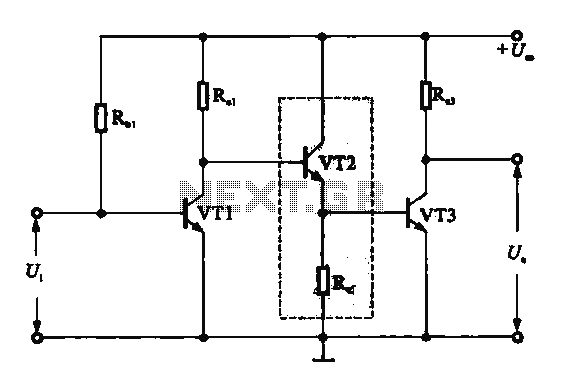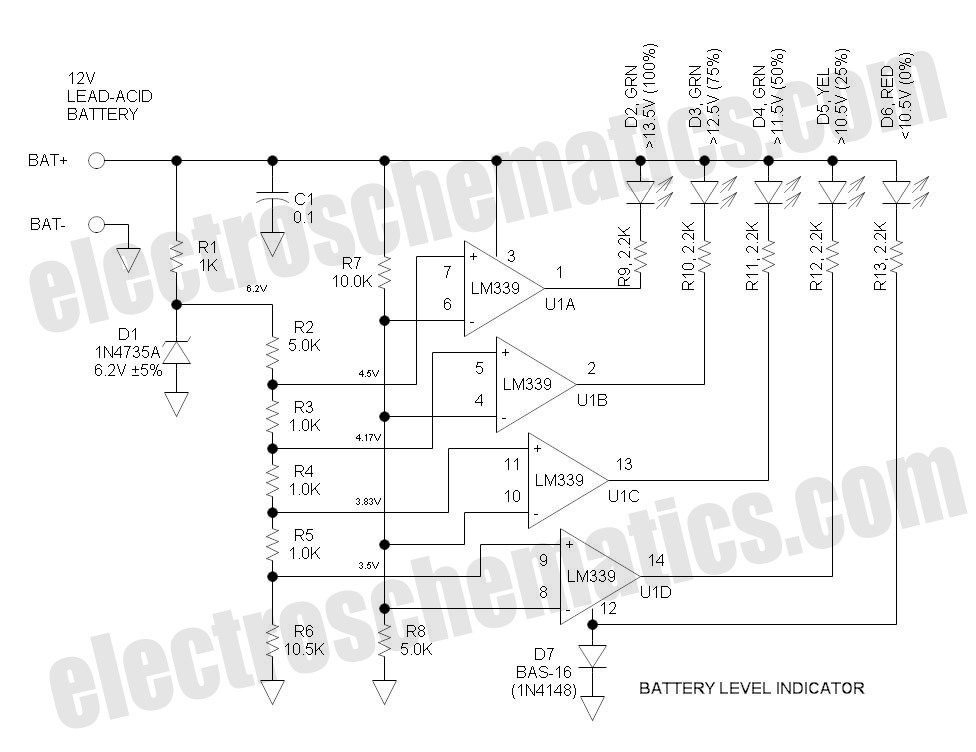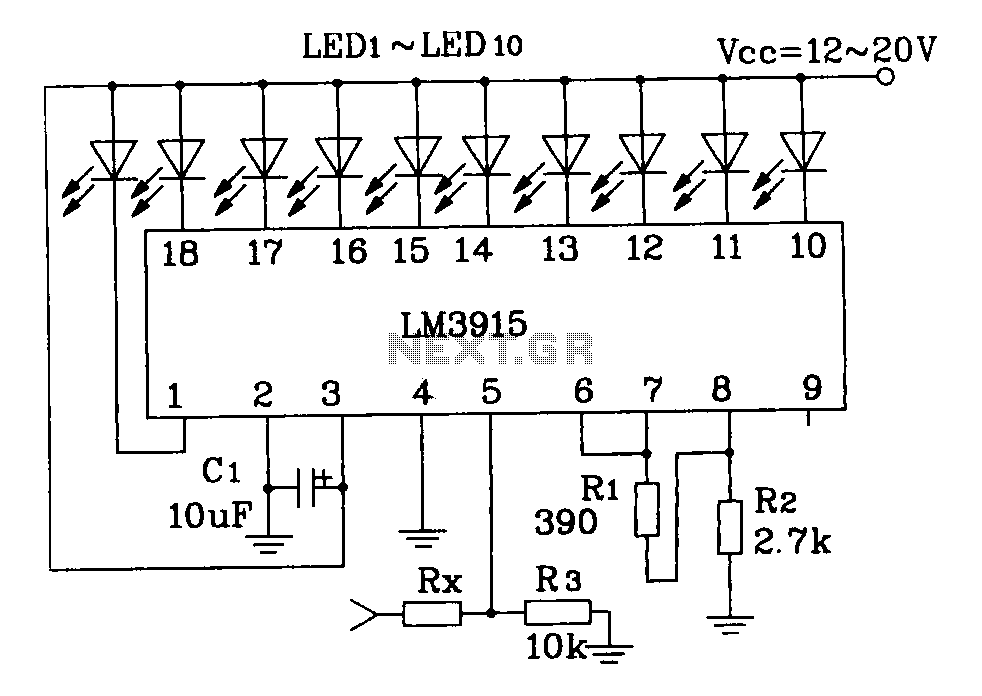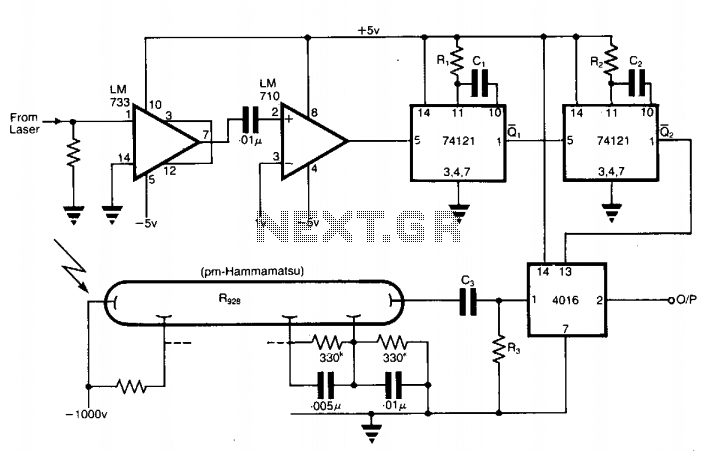
High pressure alarm circuit
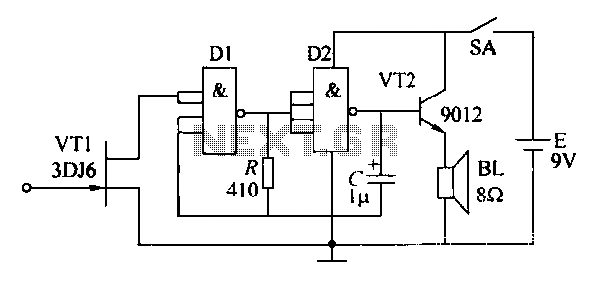
High pressure alarm with high sensitivity. It detects high-voltage electric energy from 10kV at a distance of 2m or from low-voltage mains (AC 220V) at a distance of 0.3m. The alarm device is simple to manufacture, compact, and user-friendly. The schematic circuit for alarm 13120 is illustrated in the figure. The field effect transistor (VT1) operates when its gate is influenced by an electric field, which generates a gate bias due to the induced electric field. This results in an increase in the drain-source on-resistance, causing input D1 to register a high potential. The combination of diodes D1 and D2 forms an oscillator that generates an audio signal of approximately 1kHz, which is amplified by VT2 to drive a speaker for the alarm output. Diodes D1 and D2 utilize two sets of four-input NAND gates (74HC20 or 74LS20). The remaining components can be selected based on the reference model. The device can be installed in a portable radio cabinet, with the gate pad of VT1 connected to a 10cm long plastic soft wire extending outside the case, acting as an electric field sensor. After assembly, when positioned near the 220V AC power supply line, the speaker alarm operates correctly. To ensure safety, the alarm should be tested before being used near the 220V AC power supply line.
The high pressure alarm circuit is designed to provide an effective warning system for detecting high-voltage electric fields, ensuring safety in environments where high voltage is present. The core component, the field effect transistor (VT1), is sensitive to electric fields and is pivotal in the operation of the alarm. When the gate of VT1 is subjected to an electric field, it experiences a bias that alters its conductivity, thereby increasing the drain-source resistance. This change is critical as it allows the circuit to detect potential hazards from both high-voltage sources and low-voltage mains.
The oscillator circuit formed by diodes D1 and D2 generates a frequency of approximately 1kHz, which is suitable for audible alarms. The use of a 74HC20 or 74LS20 NAND gate IC for the oscillator provides reliability and ease of integration into the circuit. The amplified signal from VT2 drives a speaker, producing a loud alarm sound, alerting users to the presence of dangerous electrical fields.
The design emphasizes compactness and simplicity, making it suitable for various applications, including portable devices. The incorporation of a soft wire extending from the transistor's gate allows for flexible placement of the electric field sensor, enhancing detection capabilities. This feature is particularly beneficial in environments where high voltage lines are present, allowing for proactive safety measures.
For installation, the device should be housed in a sturdy enclosure, such as a portable radio cabinet, to protect the components while ensuring ease of use. It is essential to conduct thorough testing of the alarm functionality before deployment, particularly in proximity to high voltage AC power lines, to guarantee operational reliability and user safety. Proper calibration and positioning of the sensor will optimize the alarm's sensitivity and responsiveness, ensuring effective monitoring of high-voltage electric fields.High pressure alarm High sensitivity, high-voltage electric energy in the body from lOkV 2m at or away from the low-voltage mains (AC 220v) 0.3m at the alarm device yuan less device, the circuit is simple, easy to manufacture, small in size, easy to use. Schematic circuit alarm 13120 is shown in Fig. Field effect transistor is a field effect transistor VT1 device when its gate near the electric field due to the induced electric field generated gate bias. Drain-source on-resistance between the emergency will increase, corresponding inputs Dl showed a high potential by Dl, D2 vibration constituted oscillator start-up, resulting in approximately lkHz audio signal, the signal by VT2 amplified speaker sound an alarm input .
Dl, D2 using two sets of four-input NAND gate 74HC20 (74LS20). The remaining components of the reference model icon or parameter selection. The machine can be installed in the portable radio cabinet, on the VT1 gate pad section lOcm long plastic soft wire, extending outside the case for the electric field sensor chip used. After the assembly, which was close to the 220V AC power supply line, a speaker alarm sound is working properly, it can make use.
To ensure safety, the alarm fulfilled prior to use electricity, which is close to 2ZOV AC power supply line, such as the alarm can be used.
The high pressure alarm circuit is designed to provide an effective warning system for detecting high-voltage electric fields, ensuring safety in environments where high voltage is present. The core component, the field effect transistor (VT1), is sensitive to electric fields and is pivotal in the operation of the alarm. When the gate of VT1 is subjected to an electric field, it experiences a bias that alters its conductivity, thereby increasing the drain-source resistance. This change is critical as it allows the circuit to detect potential hazards from both high-voltage sources and low-voltage mains.
The oscillator circuit formed by diodes D1 and D2 generates a frequency of approximately 1kHz, which is suitable for audible alarms. The use of a 74HC20 or 74LS20 NAND gate IC for the oscillator provides reliability and ease of integration into the circuit. The amplified signal from VT2 drives a speaker, producing a loud alarm sound, alerting users to the presence of dangerous electrical fields.
The design emphasizes compactness and simplicity, making it suitable for various applications, including portable devices. The incorporation of a soft wire extending from the transistor's gate allows for flexible placement of the electric field sensor, enhancing detection capabilities. This feature is particularly beneficial in environments where high voltage lines are present, allowing for proactive safety measures.
For installation, the device should be housed in a sturdy enclosure, such as a portable radio cabinet, to protect the components while ensuring ease of use. It is essential to conduct thorough testing of the alarm functionality before deployment, particularly in proximity to high voltage AC power lines, to guarantee operational reliability and user safety. Proper calibration and positioning of the sensor will optimize the alarm's sensitivity and responsiveness, ensuring effective monitoring of high-voltage electric fields.High pressure alarm High sensitivity, high-voltage electric energy in the body from lOkV 2m at or away from the low-voltage mains (AC 220v) 0.3m at the alarm device yuan less device, the circuit is simple, easy to manufacture, small in size, easy to use. Schematic circuit alarm 13120 is shown in Fig. Field effect transistor is a field effect transistor VT1 device when its gate near the electric field due to the induced electric field generated gate bias. Drain-source on-resistance between the emergency will increase, corresponding inputs Dl showed a high potential by Dl, D2 vibration constituted oscillator start-up, resulting in approximately lkHz audio signal, the signal by VT2 amplified speaker sound an alarm input .
Dl, D2 using two sets of four-input NAND gate 74HC20 (74LS20). The remaining components of the reference model icon or parameter selection. The machine can be installed in the portable radio cabinet, on the VT1 gate pad section lOcm long plastic soft wire, extending outside the case for the electric field sensor chip used. After the assembly, which was close to the 220V AC power supply line, a speaker alarm sound is working properly, it can make use.
To ensure safety, the alarm fulfilled prior to use electricity, which is close to 2ZOV AC power supply line, such as the alarm can be used.
